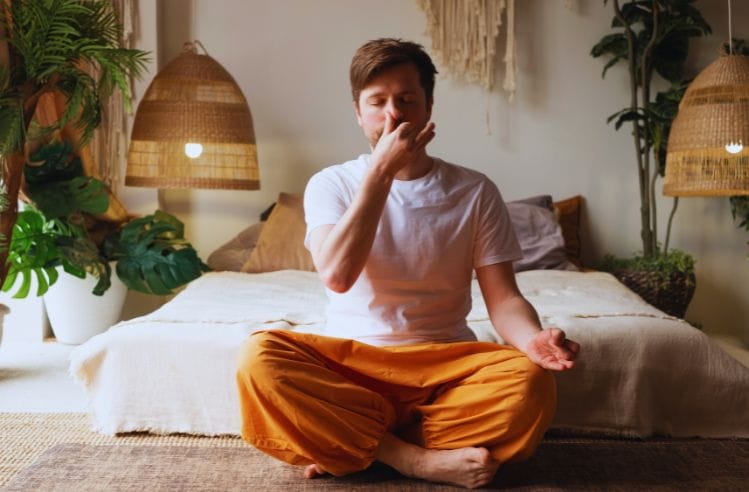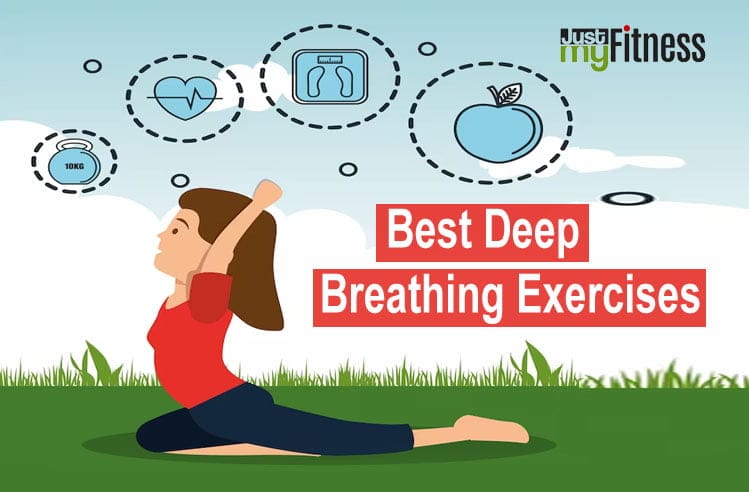Breathing exercises are good in helping one to be able to calm down stress and be clear minded while you are physically healthy in your life. Deep and even breathing helps your body and mind become calm and balanced. This functioning leads to the tranquility of the mind. A long, deep breath in a new environment has many advantages, for example, sleep improvement, alleviating anxiety, and the breathing of fresh air into the lungs. These activities are easy to do at home or someplace comfortable with basic processes. In this guide, deep exercises of calmness will be discussed.
What are the Best Deep Breathing Exercises
You do not need a specific place or schedule for breathing exercises, and you can try them anywhere when you want to relax. Many breathing techniques help your health and promote mental well-being. In the below section, we have briefly discussed the best breathing exercises that help your health. Find out below:
Diaphragmatic Breathing
Diaphragm breathing has many benefits for your lungs and makes you stress-free.
Practice this exercise by following below steps:
- Comfortable Seating or Lying Position: Find a comfortable place to sit or lie down. To do this activity, you can sit on a chair with flat feet on the floor. Place a pillow under your head and knees.
- Place a Hand on Your Abdomen: With one hand on your abdomen, placed slightly below your ribcage, place the other hand on your chest.
- Inhale Slowly: Now, you can proceed by breathing slowly through your nasal cavity. As you breathe in, try to fill the lower parts of the lungs, enabling the abdomen to heave outwardly. Your chest should stay fairly still.
- Exhale Completely: Experience how your chest rises and falls with your breathing, and exhale slowly through your mouth or nose, releasing tension. With every exhalation, your abdomen should lie a little.
- Repeat: Keep this sequence, breathe deep and blow hard. Aim for slow, calm breathing and slightly elongated exhalation phase than the inhaling for maximum relaxation.
Box Breathing
Box breathing also referred to as square breathing, is one of the most effective and organized deep breathing methods utilized or infused to change the game in the struggle to manage stress or as a way of achieving focus.
To practice box breathing, follow these steps:
- Inhale (4 seconds): To begin pace, count slightly your way to a steady four seconds deep breath through the nose. As you inhale, mentally visualize your lungs filling up with air and let your belly rise along with the inhalation.
- Hold (4 seconds): In these seconds, just hold. This small interval between inhalation and exhalation provides time for oxygen to do its round, bring peace of mind, and create inner stasis.
- Exhale (4 seconds): If you prefer, exhale slowly and fully for the same count of four seconds through the mouth or nose. Focus on letting go of any tension while you exhale.
- Pause (4 seconds): After you completely exhale it is very important to pause for an additional four seconds before repeating the cycle.
4-7-8 Breathing
The inhalation, breath retention and exhalation are specifically enumerated by the counting rhythm in the 4-7-8 pattern. This breathing technique is mostly used to enhance sleep.
Here’s how to practice 4-7-8 breathing:
- Inhale (4 seconds): Begin with parting your lips and making a sound of whooshing the air out of your mouth while exhaling completely.
- Hold (7 seconds): Seven seconds after the inhalation, close your mouth. During this interruption, your bloodstream circulates oxygen through your body to energize you and gives temporary respite to your mind.
- Exhale (8 seconds): And now release the air through your mouth with a count of eight seconds. As you breathe out, picture the muscles in your body as well as in your mind releasing any tension and stress.
- Repeat: Proceed to the 4-7-8 cycle for a few rounds, preferably repeating it four times or at least when a profound relaxation is attained.
Alternate Nostril Breathing
Alternate Nostril Breathing is part of some yoga traditions. The people try this breathing exercise to freshen their mind and reduce the stress.
- Hand Position (Mudra): Use your right thumb to close off your right nostril and your right ring finger to close off your left nostril.
- Begin with Exhalation: Breathe through your left nostril.
Inhale Through the Left: Inhale slowly and deeply through your left nostril.
- Close Both Nostrils: Close off both nostrils through your fingers.
- Hold the Breath: Hold your breath for a while.
- Exhale Through the Right: Release your right thumb from your right nostril and exhale through your right nostril.

Kapalbhati Pranayama
Kapalbhati is the best breathing exercise to lose weight and make your body balance. It will also improve your blood circulation and add shine to the face.
How to Practice Kapalbhati:
- Sit with a straight back elevation, and press your hands palms flat on the knees.
- Take a breath in.
- Quickly blow out deeply through both nostrils by tightening your abdominal muscles.
- Proceed with the rapid, strong bursts, breathing in a rhythmic fashion. People starting out an approximate break at 10-14 exhalations per cycle in the beginning, gradually increasing with the practice.
- While doing Kapalbhati, center your attention on the movement of your abdomen and the sudden expulsions. Avoid active, forced inhalations.
- Once the required number of exhalations is had, take a deep, calming breath through both nostrils.
Ujjayi Breathing
The activity of ujjayi breathing gives an opportunity to you to relieve your mind of any stress and calm it down. It provides many positive aspects associated with your body and takes you into a comfortable position.
- Relax and Breathe Normally: So, spend a few moments taking natural breaths; don’t try to control them but rather establish your baseline breathing pattern.
- Engage the Throat: Slightly contract the posterior pharynx, causing minor airway reduction. This constrict can be likened to a feeling of whispering. It is the essential part of generating the Ujjayi tone.
- Inhale Deeply: Breathe deeply and slowly through your nose and let the breath pass your throat which is constricted. As you make this, there is the sound that should be audible and resemble the waves of the ocean or a light snoring.
- Exhale Completely: Blow out slowly and completely through the nose, retaining the mild compression in your throat. The exhalation should sound like the inhalation; the sound should be like the ocean.
- Maintain a Rhythmic Pattern: Proceed sloan, mediate cycle of Ujjayi breathing. Starts the inhalation through the nose, making the sound and then exhales making the same sound.
- Focus on the Breath: As you go about your Ujjayi, be intentional in the sound and feel of the breath. This mindfulness can provide an excellent ground to your thoughts and as well making your practice deeper.
Pursed Lip Breathing
Pursed lip breathing improves respiratory function, alleviates shortness of breath, and reduces anxiety related to breathing difficulties. It is the best practice to improve breath control.
- Inhale through the Nose: Take a normal breath for four seconds.
- Purse Your Lips: As you prepare to exhale, gently purse your lips as if you were about to blow out a candle. Keep the opening between your lips small but not tight.
- Exhale Slowly: Exhale slowly and steadily through the pursed lips. Make the exhalation longer than the inhalation.
- Breath Out: Now concentrate on the sensation of the breath leaving your body.
Lion’s Breath
Lion’s Breath brings the benefits in the mental, emotional and the physical realm. It can enlarge your lung capacity and sleep.
- Find a Comfortable Seat: Cross-legged or kneel on your heels (Vajrasana).
- Posture: Keep your spine straight and hold an erect posture. Place your hands on your knees or thighs, finger up.
- Inhale Deeply: Breathe in through your nose.
- Open Your Mouth Widely: stick out your tongue as far as it will go outwards from the chin. Open your eyes and mouth wide.
- Exhale with a Roar: As you breathe, sigh so hard that others can hear it, simultaneously, stretching facial muscles. The exhale must be loud. The sound should like the sound of a lion. Imagine with this breath, you release all tension, stress, and negativity.
- Express Yourself: On emitting with the roar of the lion, let loose emotions bottled up, frustrations and anger pending. This beaks loose emotion.
Conclusion
Breathing exercises into your daily life routine benefit you in physical, emotional, and mental changes. Each technique, like the calming diaphragmatic breathing or the energizing Lion’s Breath, has its own special benefits. You can do this practice at a comfortable palace at your home or any other relaxing place. Breathing gives your body oxygen, improves your sleep, and provides you with inner peace. Pick the method that feels right for you, and let the special power of mindful breathing make your life better in ways you might not have thought of before.


